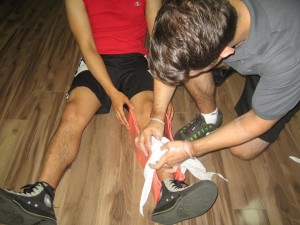Overview
Generally defined, a laceration is a cut in your skin that is typically caused by any kind of a sharp object. Depending on how deep the laceration actually is, treatment options for it can actually vary.

Treatment Steps
*Stay safe. If you are not the individual who has been lacerated, take the precaution of wearing any protective equipment that you may have at your disposal. Generally, lacerations tend to involve a great deal of blood, which is something you should always try to avoid coming into contact with.
*Control the bleeding. The biggest concern with any laceration is blood loss, which makes it extremely important to control the bleeding as much as you can. Put pressure on the laceration by holding it above heart level for approximately 15 minutes, which should be long enough to get the bleeding to stop. If this doesn’t work, try using pressure points. Avoid using tourniquets of any kind unless you’re sure that medical care will be delayed for a period of several hours. If blood loss still will not stop, call 911 immediately.
*Wash the laceration. When the bleeding has stopped, wash the laceration and the area around it with mild soap and warm water. If the laceration has stopped, there is the chance that the bleeding may start again even after it’s stopped. If this happens, repeat the second step.
*Determine if stitches will be needed. Lacerations that are wide and/or deep will typically need stitches. If this is the case, transport the victim to the nearest emergency room immediately. A larger-sized laceration can heal even without stitches; however, it’s still a good idea to have the wound stitched because it will heal much more quickly, keep it from scarring, and prevent bacteria from entering it. If the laceration is small enough and doesn’t require stitches, simply use antiseptic ointment on it and close the wound with butterfly closures. These will also help to keep the wound clean and prevent it from getting infected.
*Cover the entire laceration with sterile gauze, taping it in place. You may also wrap it in place with roller gauze.
*Keep an eye on the laceration and make sure it doesn’t get infected. Additionally, change all of the bandages every day and put fresh ones on it, making sure to clean the laceration every time you do. If you notice that the laceration is either swelling up or pus is draining from it, contact your doctor immediately.
*If the laceration is causing you pain, take ibuprofen or acetaminophen. Both of these are excellent pain relievers.
Treatment Tips
Should the laceration become contaminated in any way, you will need to contact your doctor as soon as possible in order to receive a booster or tetanus shot. Wounds such as those on your feet, ones that can’t be cleaned immediately, and ones caused by animals are all that can come at a very high risk of becoming contaminated. Furthermore, lacerations that are caused by animals can also potentially cause rabies. If you suffer any kind of a wound from an animal, contact your doctor immediately.
More Information
The details posted on this page on lacerations is for learning purposes only. To learn to recognize and manage severe internal and external bleeding sign up for a first aid course with one of our training providers. Lacerations are covered in the standard first aid course.
Related Video On Lacerations
https://www.youtube.com/watch?v=9axgLnPzGRc
